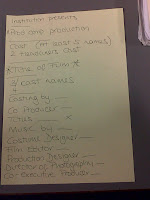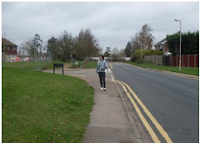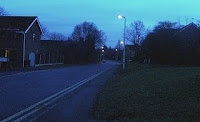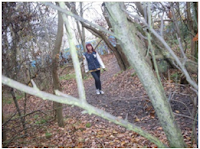Saturday, 1 January 2011
Wednesday, 8 December 2010
Research into Titles - Lucy Clark Re-sit 4124
I have been researching how titles and credits are used in films, and in particular in the horror genre. To do this I have watched the openings of several films and then listed the order in which people are acknowledged. This is a copy of my basic notes I made after watching the opening of "Catch Me if you Can". I have found that the institution and production company's names come first, followed by the main cast members or the most well known. The title of the film would be next and then the remaining cast members. After all of those would be the casting director and co-producer and then the rest is shown in my photograph of the list I made.
I have watched the openings of several films and then listed the order in which people are acknowledged. This is a copy of my basic notes I made after watching the opening of "Catch Me if you Can". I have found that the institution and production company's names come first, followed by the main cast members or the most well known. The title of the film would be next and then the remaining cast members. After all of those would be the casting director and co-producer and then the rest is shown in my photograph of the list I made.
 I have watched the openings of several films and then listed the order in which people are acknowledged. This is a copy of my basic notes I made after watching the opening of "Catch Me if you Can". I have found that the institution and production company's names come first, followed by the main cast members or the most well known. The title of the film would be next and then the remaining cast members. After all of those would be the casting director and co-producer and then the rest is shown in my photograph of the list I made.
I have watched the openings of several films and then listed the order in which people are acknowledged. This is a copy of my basic notes I made after watching the opening of "Catch Me if you Can". I have found that the institution and production company's names come first, followed by the main cast members or the most well known. The title of the film would be next and then the remaining cast members. After all of those would be the casting director and co-producer and then the rest is shown in my photograph of the list I made. The reason it is important to research how titles and credits are presented is because it helps to make a film look professional and polished, because it is complying with expectations. When editing our horror film opening, we will ensure that we take this into consideration and follow these guidelines.
In "Catch Me if you Can" the plot of the film itself is hinted at throughout the title sequence, and shown to a certain degree. Whilst the order in which the titles are shown comply with typical film title sequences, it is done in quite an original way through animation. This is something we will try to replicate; a title sequence that conforms with the correct layout but also is something a little bit different.
Friday, 29 October 2010
Location Scouting Re-Sit
The reason we do location scouting is so that when it comes to filming and making a filming schedule, we can be almost certain on exactly where each scene is filmed. Most of the scenes where the female character is walking will be along Court Road in Broomfield but shown from different angles and view points to connote to the audience that there is more than one stalker, and that they are working together. The flashes of video inside the house will be filmed in Emmaline's house because it is close to the other locations we are looking at filming in, and therefore means we can get more filmed each day because there will less travelling to do. For the flashes of video where you just see the six victims laying dead, we will use various parks and alleyways around the Broomfield area, which is again down to trying to fit in as much filming as possible in the short amount of time that we have. I think that this will work well and look effective because it is obviously in the same area, and so the audience will begin to suspect that the woman seen in the first two minutes will be reaching the same fate, and begin to fear for her.

 This is Court Road, shown from two different angles and times. The second photo is more representative of the time we would actually film the scenes where the female protaganist is walking down it, because traditionally the dark is scarier than the light, and is when bad things happen in horror films, for example, the film "Scream" the telephone call between the victim and the male antagonist takes place at night when she is on her own.
This is Court Road, shown from two different angles and times. The second photo is more representative of the time we would actually film the scenes where the female protaganist is walking down it, because traditionally the dark is scarier than the light, and is when bad things happen in horror films, for example, the film "Scream" the telephone call between the victim and the male antagonist takes place at night when she is on her own.

This is one of the places we are looking at fiming in, because is looks very quiet and secluded, and therefore when it is slightly darker, will look foreboding to the audience. In fairytales, traditionally villains hide or are banished to forests or woods, and so that idea fits in well with the idea of people following her through there. Also, it provides us with interesting shots through tree branches which again adds to the sense of someone watching her.

 This is Court Road, shown from two different angles and times. The second photo is more representative of the time we would actually film the scenes where the female protaganist is walking down it, because traditionally the dark is scarier than the light, and is when bad things happen in horror films, for example, the film "Scream" the telephone call between the victim and the male antagonist takes place at night when she is on her own.
This is Court Road, shown from two different angles and times. The second photo is more representative of the time we would actually film the scenes where the female protaganist is walking down it, because traditionally the dark is scarier than the light, and is when bad things happen in horror films, for example, the film "Scream" the telephone call between the victim and the male antagonist takes place at night when she is on her own.
This is one of the places we are looking at fiming in, because is looks very quiet and secluded, and therefore when it is slightly darker, will look foreboding to the audience. In fairytales, traditionally villains hide or are banished to forests or woods, and so that idea fits in well with the idea of people following her through there. Also, it provides us with interesting shots through tree branches which again adds to the sense of someone watching her.
Film Brief Re-sit
I rewrote and updated our film brief, which can be found here on the group blog. The reason we created a film brief is so that we have a basic storyline to follow, and even though we don't make the entire film, it enables us to have something to work from, ensuring that hints are given in the trailer to help the audience work out what is happening. It also shows that we understand the conventions of horror films and are able to apply these to our own work.
Our brief is to create the two minute opening of a horror movie, including a title sequence and the institution logo. We will need to make a film production company name and the logo to go with it.
Horror films in particular use their openings very effectively; normally within the first few minutes, the over all plot is hinted at and the viewer is aware of what is to come later on. Another way the openings attract viewers is that, especially in thrillers, the audience is given a series of clues which help them reach the overall conclusion of what will happen. In "The Exorcism of Emily Rose" the ending on the film is shown first, which captivates the audience because they want to know how and why that ending was reached.
The over all plot of our film revolves around stalking. The film would see six young women being stalked in various places and ways by hooded or masked men. The women would be seemingly unconnected, apart from the fact that they are being stalked by presumably the same men.
All the women, once caught, would be taken to the same remote location in the countryside, which is down long and winding roads, creating a sense of foreboding for the audience. The exact location is never shown for the same reasons. It can also be seen as mirroring the anonimousity of the stalkers themselves.
The idea behind the plot is that each member of the "stalking group" are targeting their victims not only for a slightly erotic reason but are sycophantic; all females own something they require/desire. i.e a body part (such as limbs, eyes, hair). The antagonists are a group of psychotic scientists aiming to create their perfect being and relentlessly killing any object of their desire along the way. As the film itself progresses, the women will be seen together, laying unconscious with big, bold, black crosses marking various aspects of their body. This will highlight to the audience the body parts the scientists require from that particular person, and reiterate their final goal of creating the perfect person from various bodies. This idea is reminiscent of the novel "Frankenstein" and although the idea of creating the perfect person from different bodies is explored in the novel, the method and the over all production is entirely different.
Our opening 2 minutes shows an example of one of the characters attack on her way home from an unknown destination. The audience are made aware during her journey that she is being followed although she is not. We view her walk away and every so often the camera flicks forward in time for a short loud burst of the attack on her that is yet to take place. The camera will then switch back to her journey home. The flashes will become more regular throughout the two minute opening, becoming shorter and quicker to give a flickering film reel effect, detailing exactly how the woman was caught and subsequently tortured. The film flashes show her with the antagonists inside her house and eventually attacking her. The forward flashes become quicker until the present time zone catches up with the beginning of the flashes as the female goes to let herself in her house.
We hope this will leave our audience in suspense, questioning what the marks on the bodies mean. We plan to give no clear indication of the state of the females and how many there are to keep the audience questioning the scene. It will not become apparent until right at the end that one of the women survives, and which woman it is. The audience becomes aware of this when she is telling her story in a court room after she escapes. The antagonists will be seen for the first time unmasked, where they look completely normal and unassuming, making the audience feel unease because this highlights that stalkers and murderers could be anyone, and you can never tell. The sharp frames we hope will shock the audience but also indicate whats in store throughout the rest of the film. The main idea of our opening is not a clear cut version of events but clues and hints that firstly may make little sense but as they come together create more answers, yet more anticipation.
Our brief is to create the two minute opening of a horror movie, including a title sequence and the institution logo. We will need to make a film production company name and the logo to go with it.
Horror films in particular use their openings very effectively; normally within the first few minutes, the over all plot is hinted at and the viewer is aware of what is to come later on. Another way the openings attract viewers is that, especially in thrillers, the audience is given a series of clues which help them reach the overall conclusion of what will happen. In "The Exorcism of Emily Rose" the ending on the film is shown first, which captivates the audience because they want to know how and why that ending was reached.
The over all plot of our film revolves around stalking. The film would see six young women being stalked in various places and ways by hooded or masked men. The women would be seemingly unconnected, apart from the fact that they are being stalked by presumably the same men.
All the women, once caught, would be taken to the same remote location in the countryside, which is down long and winding roads, creating a sense of foreboding for the audience. The exact location is never shown for the same reasons. It can also be seen as mirroring the anonimousity of the stalkers themselves.
The idea behind the plot is that each member of the "stalking group" are targeting their victims not only for a slightly erotic reason but are sycophantic; all females own something they require/desire. i.e a body part (such as limbs, eyes, hair). The antagonists are a group of psychotic scientists aiming to create their perfect being and relentlessly killing any object of their desire along the way. As the film itself progresses, the women will be seen together, laying unconscious with big, bold, black crosses marking various aspects of their body. This will highlight to the audience the body parts the scientists require from that particular person, and reiterate their final goal of creating the perfect person from various bodies. This idea is reminiscent of the novel "Frankenstein" and although the idea of creating the perfect person from different bodies is explored in the novel, the method and the over all production is entirely different.
Our opening 2 minutes shows an example of one of the characters attack on her way home from an unknown destination. The audience are made aware during her journey that she is being followed although she is not. We view her walk away and every so often the camera flicks forward in time for a short loud burst of the attack on her that is yet to take place. The camera will then switch back to her journey home. The flashes will become more regular throughout the two minute opening, becoming shorter and quicker to give a flickering film reel effect, detailing exactly how the woman was caught and subsequently tortured. The film flashes show her with the antagonists inside her house and eventually attacking her. The forward flashes become quicker until the present time zone catches up with the beginning of the flashes as the female goes to let herself in her house.
We hope this will leave our audience in suspense, questioning what the marks on the bodies mean. We plan to give no clear indication of the state of the females and how many there are to keep the audience questioning the scene. It will not become apparent until right at the end that one of the women survives, and which woman it is. The audience becomes aware of this when she is telling her story in a court room after she escapes. The antagonists will be seen for the first time unmasked, where they look completely normal and unassuming, making the audience feel unease because this highlights that stalkers and murderers could be anyone, and you can never tell. The sharp frames we hope will shock the audience but also indicate whats in store throughout the rest of the film. The main idea of our opening is not a clear cut version of events but clues and hints that firstly may make little sense but as they come together create more answers, yet more anticipation.
Monday, 25 October 2010
First Draft Script Re-Sit
Me and Emmaline have been working on writing a script for our film recently. The only real dialogue is right at the very start of our film when the screen is blank and so the script itself has to be very believable and able to stand alone without video to go with it. Even though there is very little dialogue, we created a script so that the actors could see how we wanted the trailer to come across. The girl we cast as our female protagonist in particular needs to know how we want her to act during the title sequence, which is when this script will be used.
I looked into how scripts are set out as well, in order to make our production as professional as possible. This is the website I used.
http://interceptfilm.co.nz/pdfs/short_intercept_correct_script.pdf
Script
I looked into how scripts are set out as well, in order to make our production as professional as possible. This is the website I used.
http://interceptfilm.co.nz/pdfs/short_intercept_correct_script.pdf
Script
Storyboard Re-Sit
We've been taking photos recently for our story board, showing stills of each part of our opening. We're doing this because it then gives us something to refer back to when we start filming, and it means we can get a good idea to start with as to how the over-all piece will look. These initial photos weren't taken exactly where we would film but are pretty close to what we imagined each shot to look like. The photographs in the house are a definate location choice, as are the shots in the wooded area, although we may change the type of shots depending on what works best for us during filming, in regards to lighting and weather. By including the type of shot we imagine in the storyboard, it makes it easier for us to visualise how the piece will look, and also makes filming quicker because we have already determined what most of the shots will be.
These are the storyboards I have created.
Storyboard 1
Storyboard 2
Storyboard 3
These are the storyboards I have created.
Storyboard 1
Storyboard 2
Storyboard 3
Monday, 18 October 2010
G321 January Re-sit
I will be re-sitting my G321 coursework and so will be posting and amending previous work on this blog from now on. Additions to previous work will be highlighted in bold and in blue.
Subscribe to:
Comments (Atom)